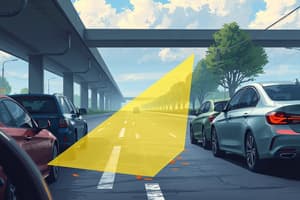Podcast
Questions and Answers
What does the term 'maneuver' refer to?
What does the term 'maneuver' refer to?
- The type of car you drive
- A type of parking
- The distance to the next intersection
- Changes in the speed or position of your vehicle (correct)
What are examples of common maneuvers?
What are examples of common maneuvers?
Lane changes, turns, and parking
What are common errors when changing lanes?
What are common errors when changing lanes?
Neglecting to use your turn indicator, decreasing speed before/after steering, moving too close to the vehicle ahead
What is required when turning into the flow of traffic?
What is required when turning into the flow of traffic?
Starting a left turn too soon may increase the risk of being involved in a collision.
Starting a left turn too soon may increase the risk of being involved in a collision.
If you start a right turn too soon, your right rear wheel may strike the curb.
If you start a right turn too soon, your right rear wheel may strike the curb.
What speed should beginner drivers use when turning onto a perpendicular path?
What speed should beginner drivers use when turning onto a perpendicular path?
How far in advance should a driver signal before turning?
How far in advance should a driver signal before turning?
What are types of maneuvers when reversing direction?
What are types of maneuvers when reversing direction?
What should be considered before making a decision to reverse direction?
What should be considered before making a decision to reverse direction?
What is the best choice for turning around?
What is the best choice for turning around?
Match the types of two-point turns to their level of risk:
Match the types of two-point turns to their level of risk:
What is a two-point turn?
What is a two-point turn?
What is the safest method of a two-point turn?
What is the safest method of a two-point turn?
What characterizes a two-point turn by turning left?
What characterizes a two-point turn by turning left?
What is the riskiest method of two-point turns?
What is the riskiest method of two-point turns?
What is a U-turn?
What is a U-turn?
What defines a three-point turn?
What defines a three-point turn?
When should you do a three-point turn?
When should you do a three-point turn?
When should you not do a three-point turn?
When should you not do a three-point turn?
How should you park on a curb to the right?
How should you park on a curb to the right?
How should you park on a curb to the left?
How should you park on a curb to the left?
What is perpendicular parking?
What is perpendicular parking?
What defines angled parking?
What defines angled parking?
What is parallel parking?
What is parallel parking?
What should you do when perpendicular or angle parking?
What should you do when perpendicular or angle parking?
What are types of illegal parking?
What are types of illegal parking?
What is the maximum distance your car should be parallel parked from a curb?
What is the maximum distance your car should be parallel parked from a curb?
Where should the front wheels be positioned when parking uphill?
Where should the front wheels be positioned when parking uphill?
Flashcards
What is maneuvering?
What is maneuvering?
Changing speed or the vehicle's position while driving.
Common lane change errors
Common lane change errors
Forgetting to use turn indicators, slowing incorrectly, or merging too closely.
Turning risks
Turning risks
Starting a turn too early, increasing the risk of collisions or hitting the curb.
Turning guidelines
Turning guidelines
Signup and view all the flashcards
Reversing direction methods
Reversing direction methods
Signup and view all the flashcards
Types of two-point turns
Types of two-point turns
Signup and view all the flashcards
U-turns vs. Three-point turns
U-turns vs. Three-point turns
Signup and view all the flashcards
Curbside parking
Curbside parking
Signup and view all the flashcards
Perpendicular parking vs Angled parking
Perpendicular parking vs Angled parking
Signup and view all the flashcards
Parallel parking
Parallel parking
Signup and view all the flashcards
Signaling intentions
Signaling intentions
Signup and view all the flashcards
Illegal parking
Illegal parking
Signup and view all the flashcards
6-18 inches
6-18 inches
Signup and view all the flashcards
Uphill parking
Uphill parking
Signup and view all the flashcards
Study Notes
Maneuvers in Driving
- Maneuvering involves changing speed or the vehicle's position.
- Common maneuvers include lane changes, turns, and parking.
Errors in Lane Changes
- Turn indicators are often neglected.
- Decreasing speed before or after entering a new lane is common.
- A frequent mistake is merging into a new lane too close to the vehicle ahead.
Turning into Traffic
- Requires spatial judgment, speed control, and steering skills.
- Starting a left turn too soon increases collision risk by crossing other lanes.
- Starting a right turn too soon risks striking the curb with the rear wheel.
Guidelines for Turning
- Beginner drivers should turn onto perpendicular paths at 5-15 mph.
- Signal around 150-200 feet before making a turn.
Reversing Direction Maneuvers
- Common methods include traveling around the block, two-point turns, three-point turns, and U-turns.
- Consider traffic density, visibility, street layout, and local ordinances before deciding to reverse.
Types of Two-Point Turns
- The safest method involves backing into a driveway or light street.
- Turning left into a driveway and reversing back is a moderate risk method.
- The riskiest method is turning right, requiring backing across a traffic lane with limited visibility.
U-Turns and Three-Point Turns
- U-turns are full left turns to head in the opposite direction; avoid near pedestrians.
- Three-point turns are risky and occupy an entire lane; should be done in light traffic or when no alternatives exist.
Parking Techniques
- Park curbs right by projecting a sight line down the center of the hood.
- For left curbs, project a sight line over the left front corner.
- Perpendicular parking requires a 90-degree space for better maneuvering.
- Angled parking, often in lots, involves parking at an angle.
- Parallel parking involves reversing carefully, focusing on the vehicle's center and rear edge.
Parking Regulations
- Signal intentions when parking perpendicularly or at an angle.
- Illegal parking includes double parking, mid-block crosswalks, loading zones, and bus stops.
- Maintain a maximum distance of 6-18 inches when parallel parking from the curb.
- When parking uphill, the front wheels should be turned away from the curb.
Studying That Suits You
Use AI to generate personalized quizzes and flashcards to suit your learning preferences.




